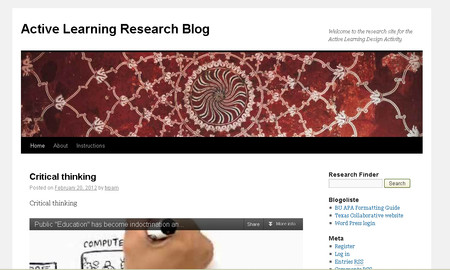Actively Blogging
For the past five years I have been using an open source methodology in my Economic Issues class. Initially this meant a few lectures on the concept of open source and its applications to education and economics. After learning about this, students would compile research regarding different evaluation methods and post them online.
Each student was responsible for bringing research, ensuring that new research added to the existing body of knowledge instead of duplicating it, and commenting on the research of others. From here the students would discuss what they felt was the most suitable evaluation method for their efforts, and I would construct the mid-term evaluation using this method.

Active Learning Research Blog on Profweb’s Web Space
An Open Source Methodology for Active Learning
This year I decided to try integrating an active learning model into the course as well, so instead of researching many evaluation methods the students were given the task of researching active learning. This information was compiled onto a blog and the students were then split into groups based on my observations. As examples, the three football players were put into different groups and the couple of quiet people were put into a group with a very outspoken person. Groups were given the task of designing an active learning evaluation for the mid-term based on the framework from James Sparks at St. Lambert.
The principle of controlled chaos was perhaps the most important aspect of the framework in this case. From the point of view of the course activity it was key in providing a level of accountability towards the active learning process and the final product while giving comfort to the participants struggling with a methodology and tools that were new and unfamiliar. The framework acted as a good roadmap without impeding the creative process.
Using a Blog to Construct Knowledge
The use of the blog and the Profweb Personal Space was born out of a discussion with Judith Beaudoin, our pedagogic counsellor at Champlain Lennoxville. I had been using a wiki previously and was looking for something that would be easier to monitor and manage. The initial learning curve for the blog and personal space was a bit steep but I had good support from the ped counsellor and Profweb tech services and once the initial bumps were ironed out everything worked very well.
Aside from the blog we used the standard resources of the Internet and Omnivox’s MIO messaging system for classroom communications, and this sufficed as far as coordinating group work document exchange. We took advantage of classroom time for live debates and the presentation of research results and project presentations.
After the initial stages mentioned earlier, the groups each presented their active learning activity idea and voted on which one to use for the mid-term. From here the whole class came together to work out the details of the activity (how to ensure objectivity in marking, an appropriate marking scheme, timeline, guidelines for content, etc.) and I pulled it all together into an assessment that gave some evaluation responsibility to both the students and myself.
The chosen activity required each group to choose an economic policy issue and develop an interactive learning activity to deliver the pertinent background concepts, facilitate debate, and develop critical thinking skills. Each group was evaluated by their peers using an objective evaluation grid developed by the class and reviewed by me. I then reviewed the evaluation results and constructed a summary class to fill in weak points identified by the students. To completely verify that the course activities were contributing to the course competencies, we added an exam component that was designed and corrected by me.
Throughout the course I inserted a few activities to demonstrate the advantages and challenges of collaboration versus competition, get the students thinking in more creative ways, and also hit them with a few very traditional lectures to try and highlight the contrast between an active classroom and a more traditional classroom.
Future Modifications
The main failing on my part was in not structuring multiple deadlines for research to be posted. I had one deadline and encouraged students to post early so that they could reflect and add to what was there, but not surprisingly most students waited until a couple of days or a day before the deadline to start posting, so the growth of research was not as natural as I would have liked. In the future I would probably give multiple deadlines for each piece of research and commentary so that this could be a little smoother. Another problem was that although most students reacted positively, some had difficulty. In the future I would spend more time familiarizing students with the tools.
The use of the blog was quite instrumental in allowing students to add material, compare, and comment on the work of others in real time. It would have been fairly difficult to allow an organic growth of research had I not been able to access a tool such as the blog. The main challenge for me was in being able to monitor and evaluate the work as it came in, but it was really more just time consuming than technically complex.
What challenges and advantages have you experienced with your students when using blogs? Have you noticed changes in your students’ thinking? Have their writing competencies improved?

